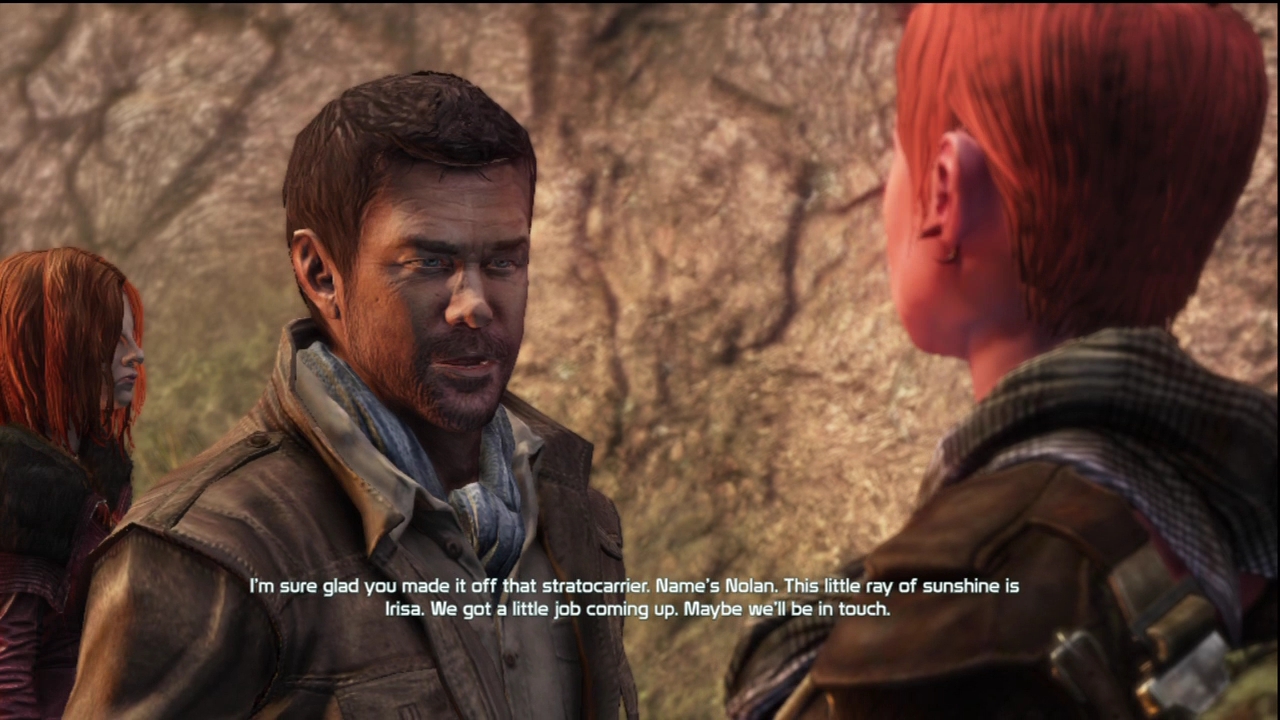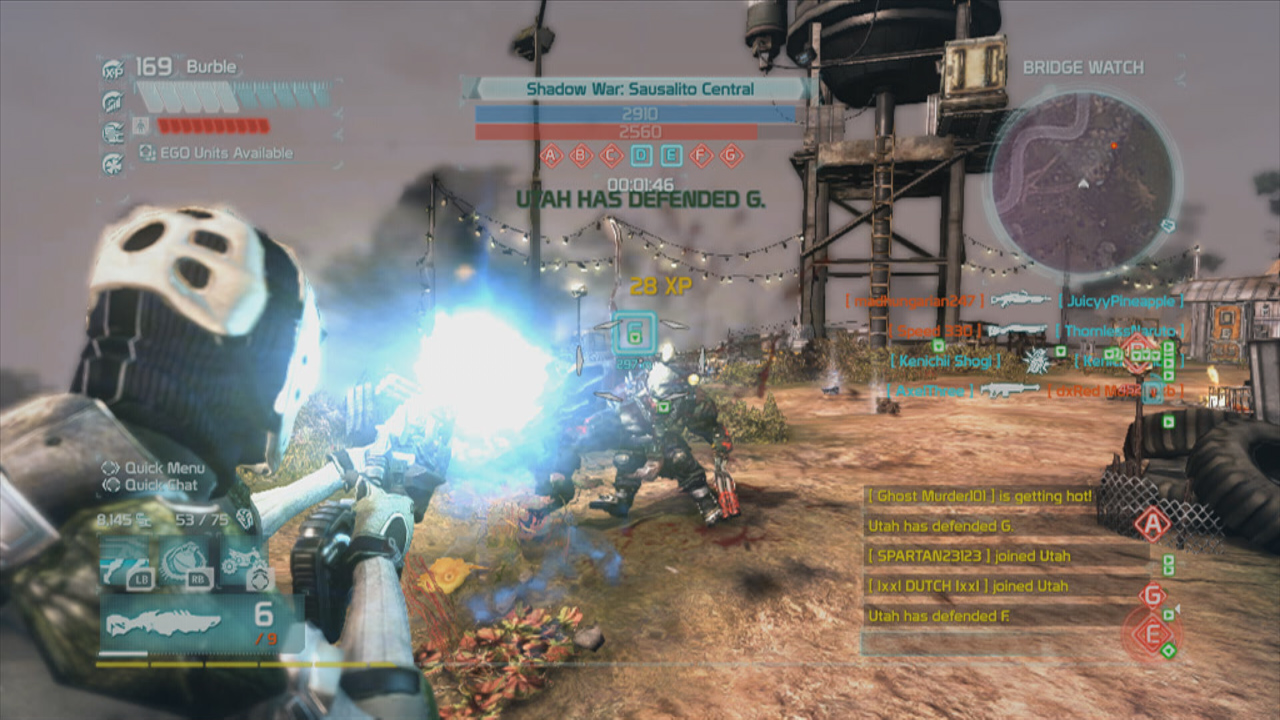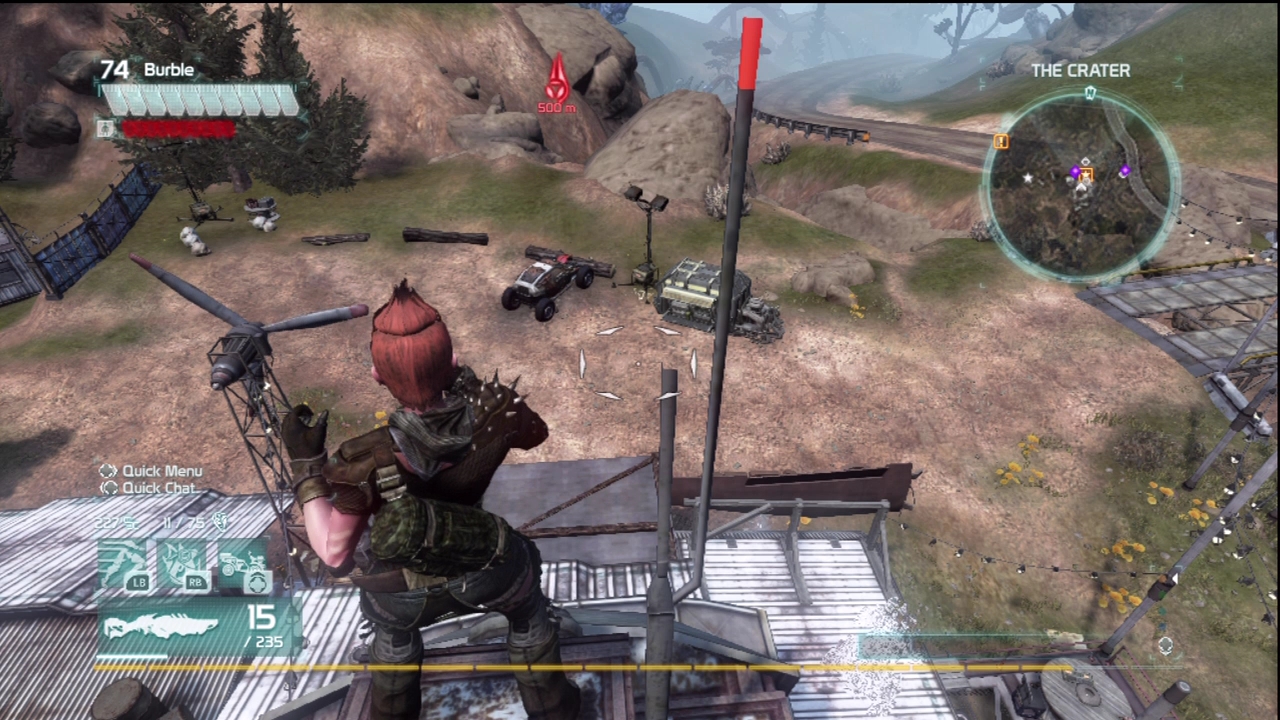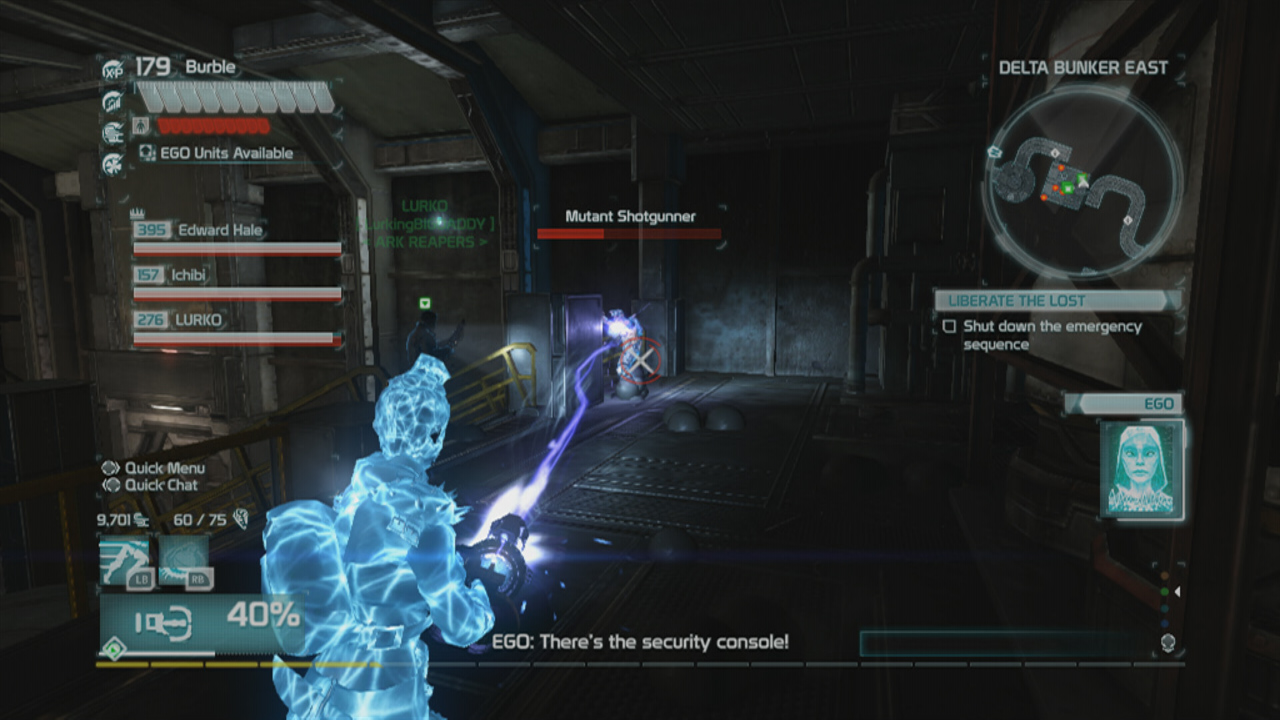Defiance is a difficult game to wrap your head around. That's not because it's all that complicated, but rather because it's just so much fun, even though none of the elements are done particularly well. Defiance is a massively multiplayer shooter in which every aspect is merely decent at best, yet it somehow pieces the jagged elements together into an entertaining picture as you pursue one challenge after another across its postapocalyptic landscape. What a shame that the trek is interrupted not just by the squishy kinds of bugs that you like to kill with guns and grenades, but technical kinds of bugs that have you cursing and rolling your eyes.
Look beyond the hitches and the jittering frame rates, and you discover a game with a scrappy attitude and a tight handle on what a massively multiplayer world needs to keep you coming back in spite of the frustrations. What is this world? Well, it's Earth, as it happens--more specifically, the San Francisco Bay Area. An alien war has ended, and an uncertain peace between exhausted factions remains. The decrepit remnants of an annihilated fleet of spaceships orbit the planet, occasionally plummeting to the land beneath, and drawing in treasure hunters eager to scour the remaining debris for valuable commodities. Terrestrial and extraterrestrial plant life have merged, causing bizarre purple flowers to grow from the gnarled branches that corkscrew above crumbling highways and rusting copied-and-pasted factories.
You shouldn't come to Defiance to be immersed in the world, which looks too monotone to be all that compelling. Ruinous environments can have their own kind of disastrous beauty, but this vision of Earth lacks the tense atmosphere and visual variety of gaming's best ravaged lands. You might become invested in this world in spite of its mundane looks, however, depending on your level of interest in the SyFy television show of the same name. Story-based missions feature the vague likenesses of characters from the show, and future story missions are promised, but stiff facial animations and inconsistent voice acting--not to mention a lot of cheesy (in the bad way) dialogue--make it hard to whip up any excitement over the narrative in spite of an abundance of cutscenes.
Massively multiplayer online games have trod in alien territory before, though MMOGs remain a rarity on consoles. Nonetheless, Defiance’s structure is a familiar one. The game pushes you from from one task to the next, having you clear meadows of giant hellbug swarms, free captured prisoners from their bonds, collect data from computer terminals, and so forth. You perform most of these missions in the open world, though key assignments might send you into instanced areas meant only for you and your groupmates.

Defiance is not a typical role-playing game, however, but a shooter through and through, so while you have special skills to perform, you can generally concentrate on aiming at your target and pulling the trigger. You initially choose one of four powers so that you can run really fast, go invisible, create a ghostly decoy, or enhance weapon damage. From there, the power grid expands, allowing you to earn and improve lots of passive perks, though you can equip only as many perks as your loadout allows, and eventually you can unlock the other powers to play around with.
These skills are called EGO powers, named after the Environmental Guardian Online artificial intelligence fused with your body. This AI is Defiance's version of Halo's Cortana, though EGO makes a far more annoying companion than Cortana, what with the sharp treble of her voice and the repetitious line readings that don't necessarily make sense in every context. (Do hellbugs really call in reinforcements, as if they have tiny radios strapped to their heads?) But you'll be glad of the abilities she grants you, which aren't very thrilling to activate or watch, but are nonetheless useful in battle. Need to shake off a flame-spewing munchkin? Distract him with your decoy, and shoot the fuel supply strapped to his back. In over your head? Turn invisible and make a quick getaway.
It isn't the powers that make for rewarding progression in Defiance, however; it's the weapons. There is a cornucopia of choices, and once you get a taste of each gun type, you'll be pleased that your inventory is constantly filling with so many deadly possibilities. Simple pistols and machine guns are soon upgraded with modifications you purchase and earn, or are replaced with similar weapons infused with effects like fire and poison. Launchers come in all sorts of varieties. You might be able to lock on to your target, or perhaps your payload explodes in midair and spews fire onto your enemies beneath. Infectors cause bugs to spawn within your victims and eat away at their flesh; biomagnetic guns allow you to siphon health from foes and grant it to friends.

And so your drive to continue playing is fueled by the ever-present possibility of a new gun, a new variant, or a modification that enhances the bond to your current weapon of choice. That bond is then broken when a shiny new toy makes the old, newly obsolete weapon a relic of the past, though weapons remain surprisingly effective for some time. In fact, the gap in weapon effectiveness that you usually feel in a persistent-world game as you level up isn't so pronounced in Defiance, due in part to how well enemies scale based on how many players are in the vicinity.
The gentle progression curve allows developer Trion Worlds to take you on a tour of its world without dividing it into territories that cater to players of specific levels. Reaching one end of the county doesn't mean having to fight your way to some arbitrary level limit, which makes Defiance feel more freeing than other online worlds, even though it doesn't cover the exhaustive amounts of real estate other games do. That isn't to say that Defiance doesn't feel appropriately large, or doesn't give you a lot to do; the world map is dotted with orange waypoints that lure you to vehicular speed challenges and side missions, and white waypoints that indicate vendors promising special guns for sale.
A typical stretch of Defiance often involves taking on a mission, summoning your ride--perhaps a speedy all-terrain vehicle or a cumbersome Dodge Charger--and zooming toward your destination. Your car appears out of thin air almost immediately after you summon it, along with a dinky horn effect that might have you looking for the clown car that must surely accompany it. In any case, it's easy to get around, and once you've arrived at your destination, you can tumble from your vehicle like a Hollywood stuntman. Then the shooting begins, and this is where so much of the fun--and so many of the problems--begins to surface.

Defiance's third-person shooting is serviceable. While you can crouch behind objects and let your shield regenerate, enemies aren't usually up for a game of cover-based cat and mouse, so you tend to be on the move, which keeps you engaged. But while Defiance has speed, it doesn't have much oomph: hitting an enemy in its weak spot results in an unsatisfying splat, and explosions cause raiders to fly through the air with too little weight. Enemy AI also proves irritatingly dunderheaded. You don't usually come to a massively multiplayer game expecting cutthroat AI, but in a shooter environment, the shortcomings are immediately obvious. Guys with rocket launchers may fire into the wall directly in front of them, over and over, and gunners might run away from you and around a corner, only to just stand there, facing the wall.
Defiance often compensates for the AI's inconsistencies by throwing a variety of enemies at you that exhibit different behaviors and use different weapons. Sometimes, this leads to exciting moments that have you rushing in and out of harm's way, getting the drop on your more vulnerable foes before taking on some hulking mutant lobbing grenades at you. Other times, you face automated turrets, multiple rocket raiders, and shield-equipped rioters. Knockback animations don't always allow you time to recover from one rocket before another from the same enemy lands. Dealing with the resulting damage loops isn't very enjoyable, and they almost invariably occur on story-based missions.
Of course, you can have buddies along if you're having trouble, though joining others isn't entirely necessary, which is just as well, considering that the in-game chat doesn't always function properly anyway. But you do need others if you want to tackle Defiance's co-op missions, which push forward at a good tempo, bubbling and surging until you reach the final boss. Some of these bosses are big bags of meat, requiring only that you plug them with enough bullets for them to fall. Others require some strategy, such as a mutated freak that requires you to disable his defenses first while staying out of harm's way. The dark mines that house some of these missions are uninspiring, but other co-op missions give you a welcome breath of fresh Bay Area air.
It's during group events called arkfalls that Defiance proves its mettle. Space debris falls from the sky, bringing with it untold treasure (mostly in the form of guns and scrip, the game's main currency), as well as throngs of raiders, hellbugs, and mechanical monsters intent on plundering your innards. These arkfalls bring together dozens of players in the vicinity intent on destroying giant creatures for the sake of loot, though it's worth joining in just for the fun of it. An arkfall is joyous controlled chaos, with winged insect archers fluttering in the air and giant robotic arms craning above the battlefield. Often, minor arkfalls are chained together, culminating in a massive standoff characterized by a final intimidating explosion. Driving from one battle to the next, you join a makeshift caravan of other greedy players, all of them joined by a selfish lust for money and valuables.
Unfortunately, arkfalls and other events populated by larger groups are sometimes bogged down by jerky frame rates, causing the gunplay to feel less fluid than it should. Graphical performance isn’t Defiance’s only technical issue, however: every strength is undermined by some kind of annoyance, some kind of glitch, or some kind of execution foible that has you either shaking your head, or scratching it.
Take, for instance, the player-versus-player mode called Shadow War. The mode drops you and other players into the open world and lets you murder each other as you strive to capture control points. At its best, Shadow War is an intense tug-of-war between two sizable teams struggling against the local wildlife in addition to each other. But why do friends and enemies spawn next to each other at the beginning of the match? You could be murdered before you even get your bearings. Later, you could enter an attack vehicle as a gunner, but have the targeting reticle disappear. Or maybe you enter the match, only for the game to act as if you were thrown to the ground, so you end up taking damage because you had the gall to respawn. And then when the match is over, you might take damage from standard open-world enemies attacking you before you've had time to close the match results screen.

The annoyances continue outside of PVP, where almost no facet can be described without mentioning some kind of notable flaw. The co-op missions are solid, except when a door shuts you out of a boss fight, and your giant foe clips halfway through the door, allowing you to punch him until he perishes. The driving challenges are enjoyable, except when an object spawns directly in front of you and you bang into it, your chance at a gold medal vanishing in an instant. The team deathmatch PVP mode is OK, though you could appear without a head or weapon for a short while. Arkfalls are terrific, even though you might get credit for performing dozens of player revivals when you only performed one.
Menus taking many long seconds before the screen populates with any information. Mission progress lost and weapons gone missing. Frequent server downtimes. Delayed or failed attempts to break down your items into resources. These are some of the obstacles you must circumvent to enjoy Defiance to its fullest, and even then, nothing Defiance does is best in class. Yet it has that special spark that ignites the desire to press forward. Defiance's merely acceptable systems are deftly assembled in a way that allows you to spread your proverbial wings and offer your gun-wielding talents to those who need you most. Much like its own arkfalls, Defiance offers treasure, but you have to battle an array of bugs before you can reap it.
